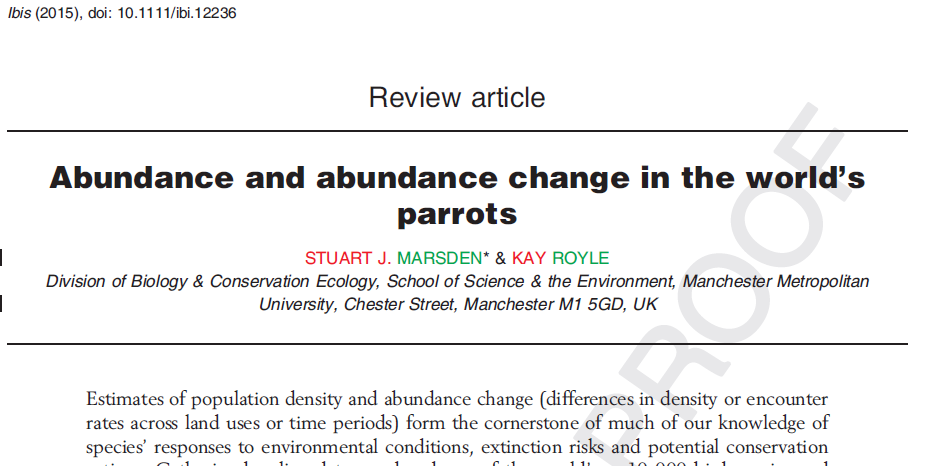Posted by Stuart Marsden & Kay Royle
A review paper, to appear in the April issue of Ibis examines natural abundance in the world’s 350 or so species of parrot, and how this abundance changes in human-altered habitats.
The review was started several years ago when Kay was a second year undergraduate student at MMU. Helping lecturers with their research is an excellent way for students to get involved in science and publish papers while still studying – it is also good for us lecturers as it is a good opportunity to get someone to do the donkey work, for which we do not really have the time. Kay is currently finishing her Masters project on vocalisations in Sylvia warblers with Selvino de Kort at MMU.
 |
| Mixed flush at Peruvian Colpa (Photo: Alan Lee) |
The aims of the review were threefold
1. To gauge how much data there are on abundance in the world’s parrots, what methods have been used in their study, and where the main gaps in knowledge are.
2. To identify if there are commonalities in abundance across parrot species – are related species likely to be similarly common?
3. To look for generalities in abundance changes when primary forest is converted to other land uses such as plantations, and small-scale agriculture.
 |
| Little Corellas in Queensland (Photo: Stu) |
A major job was finding publications and reports containing suitable data – this was done through exhaustive searches on Web of Knowledge and other on-line databases. Particularly useful was the Parrot Literature library of the newly formed Parrot Researchers Group initiated by Juan Masello. In all, we found 74 papers/reports containing abundance estimates.
 |
| Plum-headed Parakeet (Photo: Paul Donald) |
Density estimates were found for just 25% of 355 parrot species. This is a frighteningly small proportion, especially when one considers that parrots are among the better known groups of birds in the world. Even more alarming is that Threatened species were no more likely to have a density estimate than non-threatened species, and were less likely to have estimates of abundance change. The methods of choice for abundance estimation in parrots is distance sampling, either from point counts or line transects (84% of all estimates) while spot-mapping accounted for around 8% of estimates.
 |
| The wonderful Palm Cockatoo (Photo: Peter Odekerken) |
There was a ‘phylogenetic signature’ on parrot abundance – in other words, species within the same genus do tend to have more similar densities than other less-related species. Very importantly, parrot abundances are generally higher within protected areas than outside them - it is unclear whether the latter effect stems from habitat protection, a reduction in poaching or both, but protected areas appear to be beneficial for parrots.
 |
| Chestnut-fronted Macaws (Photo: Alan Lee) |
 |
| Timneh Parrots (Photo: Nat Annorbah) |
You can read an accepted version of the paper here.


This comment has been removed by a blog administrator.
ReplyDelete